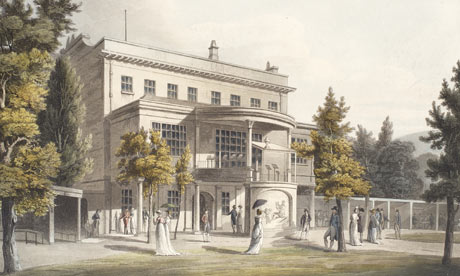Green and pleasant
England's pleasure gardens were once the centre of high society life, yet Sarah Jane Downing has found only traces of them remain today
- The Observer, Sunday 5 April 2009

Garden facade of Sydney Hotel, Bath. Photograph: PR
In the eighteenth century, England's privately owned pleasure gardens hosted royalty, nobility and famous people of the day who promenaded through exquisite, classical vistas and artfully contrived ruins in a fairyland of tinkling fountains and glittering lights. They showcased the finest musicians and artists of the day, hosting Mozart's English debut, and exhibited fine art in a public setting for the first time.
At a time when the city streets were unlit and impassable (as they perceived them) except by sedan chair, pleasure gardens offered well-to-do ladies a thrilling opportunity to meet people from beyond their proscribed circle of friends.
The gardens were also the first truly egalitarian venue, where anyone was granted admission for the price of a ticket, regardless of class. In an age almost as celebrity-orientated as our own, with nobles replacing TV stars, the gardens were the place to see and be seen.
They began to appear as England fell in love with fun again at the Restoration, and reached their height in the 1740s and 50s. In the halcyon days of the mid to late 18th century, the gardens were the backdrop to an endless parade of concerts, balls, public breakfasts, masquerades and firework displays.
For those who worked, holidays really were only single days, and before the railways made travel to the coast or countryside viable, a day at a pleasure garden on the outskirts of the city was the perfect way to unwind. By the Victorian era most pleasure gardens had lost their Arcadian chic. Offering family entertainments, balloon ascents, animal exhibits and ice-cream, they were the forerunners of the seaside or amusement park.
Tragically, little is left of such an important part of our history. Of the great London gardens, Vauxhall Pleasure Gardens was entirely lost to Victorian property development until the blitz cleared a portion of the site, which was redefined as a park after the second world war. Now restored to the original name of Spring Gardens, it remains a public park off Kennington Lane in Lambeth, with part of the site on Tyers Street dedicated to Vauxhall City Farm and the Riding Therapy Centre. Ranelagh also all but disappeared, save for a small area where the Chelsea Flower Show is now held (Royal Hospital Road, Chelsea). The fate of the provincial gardens was generally more severe. Victims of civic and industrial expansion, almost all were gone by 1860, leaving only a district or street name to mark their passing.
In Liverpool the Adelphi Hotel now marks the site of another Ranelagh Gardens, but there is still a vestige of Mount Zion at St James' Cemetery. Mount Zion was known for its beautiful views over the burgeoning city and in the recession year of 1767-8 the mayor organised a work creation scheme for the unemployed to lay out a series of gravelled walkways and a bowling green which became known as St James' Walk. Liverpool Anglican Cathedral now dominates the site, but some of the walks remain in what, during the 1820s, became St James' Cemetery, now a grade I-listed conservation area.
Sydney Gardens Vauxhall in Bath was possibly the greatest pleasure garden outside London. It boasted a labyrinth, where Jane Austen walked every day when she lived in Bath, as well as a picturesque folly of a ruined castle. Once Brunel's railway bisected the site, popularity began to wane, and by the end of the 19th century it was little more than a public park with concerts. Suffering further decline in the 20th century, there is little left apart from a bowling green and tennis courts to entertain visitors (Pulteney Road). However the space is set to return to its former glory with the current redevelopment of the Holburne Museum (bath.ac.uk/holburne) on Great Pulteney Street, once the Sydney Hotel and gateway to the gardens, and further plans to restore Sydney Gardens (Sydney Place).
• Sarah Jane Downing is the author of The English Pleasure Garden 1660-1860, published by Shire Publications, £5.99
- guardian.co.uk © Guardian News and Media Limited 2009
No comments:
Post a Comment